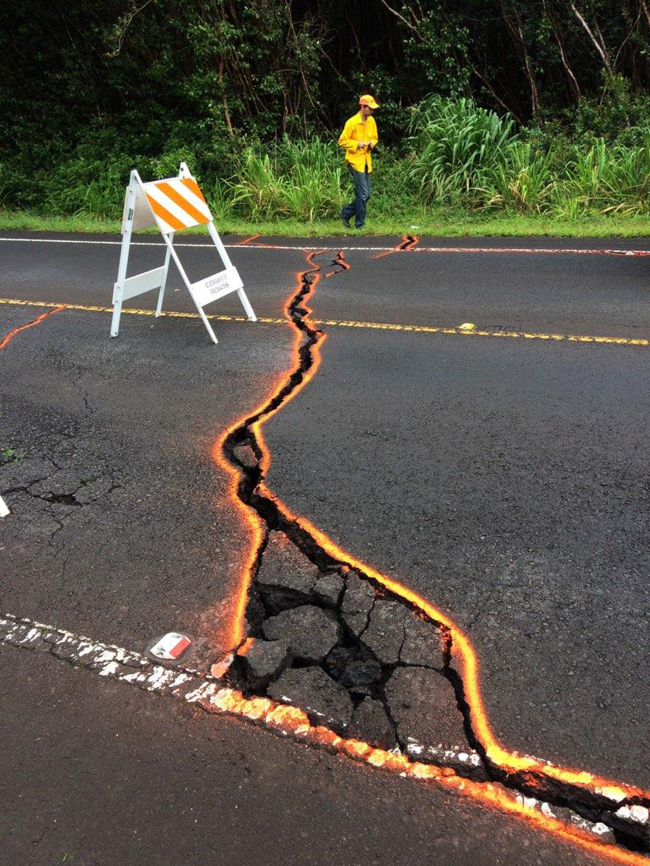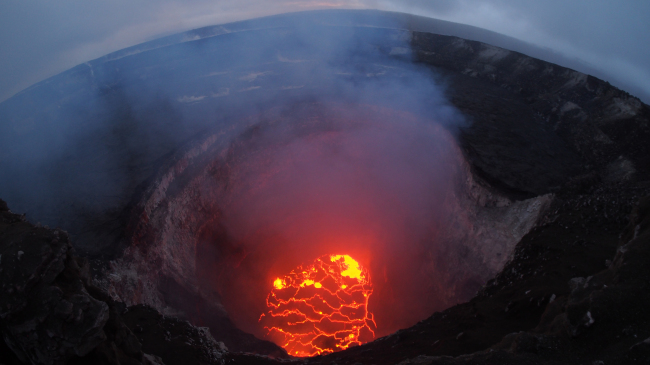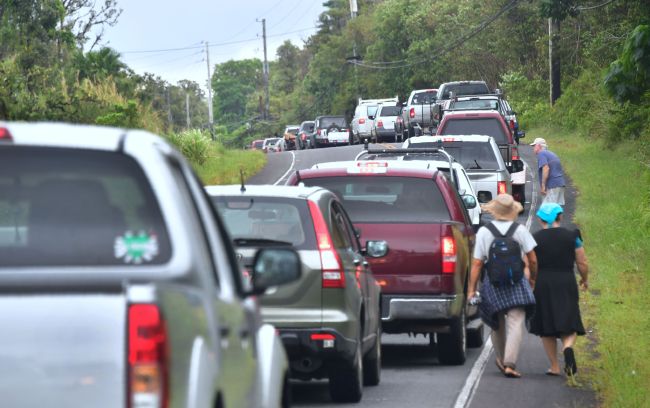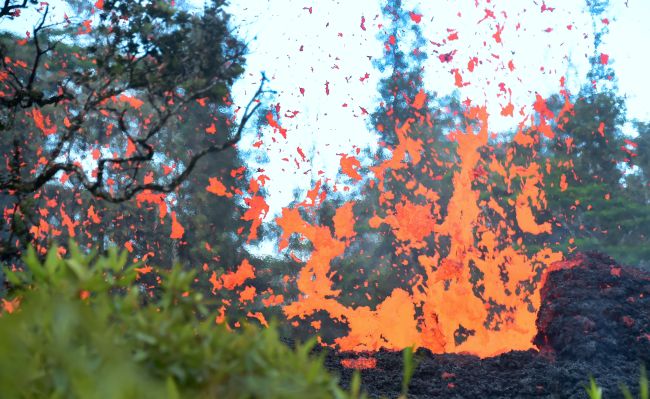Edwin Montoya's family carved their farm on the slopes of the Kilauea volcano out of "raw jungle," transforming it into a fertile collection of gardens, animal pens and fruit trees.
Now the property is imperiled by the very land it stands upon. A couple of miles up the hill, lava has destroyed dozens of homes and his daughter's farm is in an evacuation zone.
Despite the nearby danger, Montoya plans to stay unless he is forced to leave. "I'm going to go ahead and stick it out," he said. "If it happens, if it blows its top and I'm there at the time, I'm 76 years old. I've lived a good life."
Because there's no indication when the eruption might stop, or how far the lava might spread, the volcano has forced people living in and around the Leilana Estates subdivision to make tough decisions.
Some residents insist on staying to watch over their property. Others have abandoned their homes without knowing when they will be able to return, or if they will come back to find their houses turned to ash and buried under solid rock.
Andrew Nisbet evacuated last week and has no idea what has happened since.
"My home is right in the line of the major breakouts so maybe, maybe not." he said Monday during a community meeting.
Authorities urged Scott Wiggers to evacuate, but he refused.
"I'm in the safest part in the subdivision. There's no threat to my house whatsoever," said Wiggers, a tour guide.
Wiggers said he wasn't leaving his home on the outskirts of the evacuation zone because he worried that if he did, he wouldn't be able to get back in. But he's prepared in case the situation takes a turn.
"I am packed. My truck is loaded. I'm not a dumb-dumb. If I see a threat, I'm out of here," he said.
 |
| This Monday, May 7, 2018 photo from the U.S. Geological Survey shows cracks in Highway 130, outlined on orange paint, in the Leilani Estates subdivision near Pahoa on the island of Hawaii. Kilauea volcano has destroyed more than two dozen homes since it began spewing lava hundreds of feet into the air last week, and residents who evacuated don't know how long they might be displaced. (AP-Yonhap) |
Hawaii County officials issued mandatory evacuation orders for two neighborhoods _ Leilani Estates and Lanipuna Gardens _ on Thursday when the lava first emerged. About 1,700 people live in Leilani and a few hundred live in Lanipuna.
But on Tuesday, county officials sent an emergency cellphone alert telling any stragglers in Lanipuna to leave immediately. Acting Mayor Wil Okabe said that's because two new fissures were emitting dangerous gases.
Hawaii Gov. David Ige told evacuees he has called the White House and the Federal Emergency Management Agency to tell officials that he believes the state will need help to deal with the volcano on the Big Island.
Authorities are allowing some evacuees to return briefly each day to gather medicine, pets and other necessities.
Montoya, who moved to Hawaii to be with his family about six years ago, said he saw most of the United States as a truck driver for 25 years on the mainland. He prefers life on Mystic Forest Farm, in a purple octagonal house his family built nearly 20 years ago.
The farm is at the end of a long, single-lane gravel road, with large volcanic rocks scattered about and large pools of water to drive through.
Montoya is tending to the farm's animals _ sheep, chickens, rabbits and several cats and dogs _ and watching over the property to prevent looting.
 |
| The summit lava lake has dropped significantly over the past few days, and on the evening of May 6, 2018, was roughly 220m below the crater rim. This wide-angle camera view captures the entire northern portion of the Overlook crater. Eruptions in the lower East Rift Zone of Kilauea Volcano continue as the island was hit on May 4 with a 6.9 magnitude earthquake, the most powerful on the island since 1975 according to the US Geological Survey. (UPI-Yonhap) |
Officials warn that lava could flow downhill and burn areas that are not currently in danger, and toxic volcanic gas could kill people, especially the elderly and those with breathing problems.
Events remain unpredictable. On Sunday, the first day residents were allowed back in, a cellphone alert went out urging people to leave after a vent opened and began spewing sulfur dioxide. Officials were worried that some residents could become trapped.
The fumes wafted down on the farm from the open fissures above.
"It was really cloudy with a lot of sulfur in the air," Montoya said. "It hurt my throat. It was pretty miserable."
Residents of Lanipuna Gardens, a subdivision directly to the east of Leilana Estates, still cannot return because of danger from volcanic gases.
 |
| eilani Estates residents Guineverve and Matthew Underwood walk beside a long convoy of vehicles awaiting re-entry to their homes to gather belongings near the town of Pahoa on Hawaii`s Big Island on May 7, 2018, after the residents were forced to evacuate following recent earthquakes and concern over toxic sulphur dioxide. (AFP-Yonhap) |
Montoya's 45-year-old daughter, Tesha "Mirah" Montoya, wasn't especially worried about the gases. The tipping point for her to evacuate, she said, was the earthquakes that preceded the eruption.
"I felt like the whole side of our hill was going to explode," she said after a magnitude 6.9 quake rocked her land. "My heart and soul's there," she said in a phone interview from a cabin on the north side of the Big Island, where the family had hunkered down. "I'm nothing without the land. It's part of my being."
The family's property on Kilauea (pronounced kill-ah-WAY'-ah) has several buildings and cabins, gardens and animal coops. The land also has about 130 kinds of exotic fruit trees. There's a pineapple patch and enough food stored away to last a long time, she said.
There are 12 lava-producing fissures in Leilani Estates, but the flow of lava is not constant. No lava was flowing as of late Monday, said Janet Snyder, a spokeswoman for Hawaii County.
 |
| Lava is seen spewing from a fissure in the Leilani Estates subdivision on Hawaii's Big Island on May 4, 2018, where up to 10,000 people were asked to leave their homes on Hawaii's Big Island following the eruption of the Kilauea volcano that came after a series of recent earthquakes. (AFP-Yonhap) |
A total of 35 structures, including 26 confirmed homes, have been destroyed. Aerial surveys cannot make out whether some of the structures are homes or other types of buildings.
Edwin Montoya is happy staying on the farm, tending to animals and eating from the trees. He's living the life he wants, just like many in this rural landscape in the shadow of one of the world's most active volcanoes.
"It's where I want to rest my bones," Edwin Montoya said. "But nevertheless, I will survive. I'm sure I will survive." (AP)











